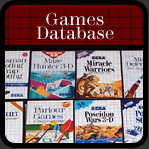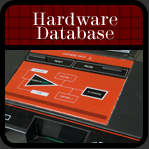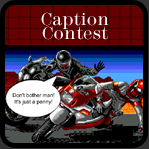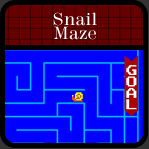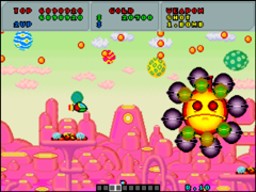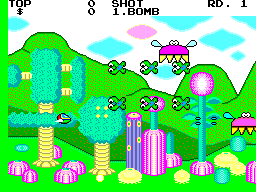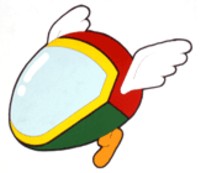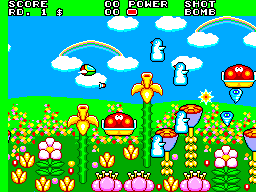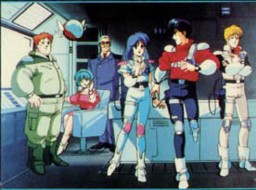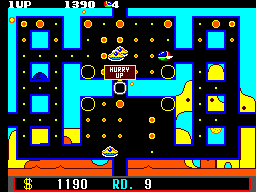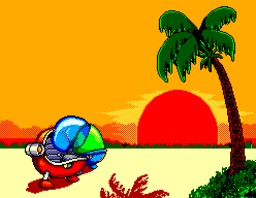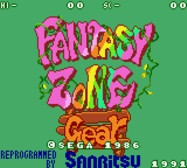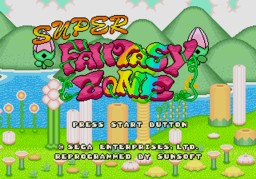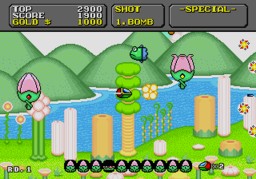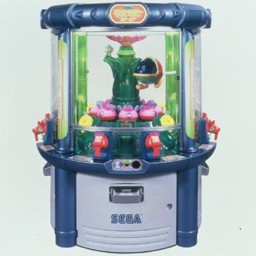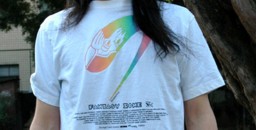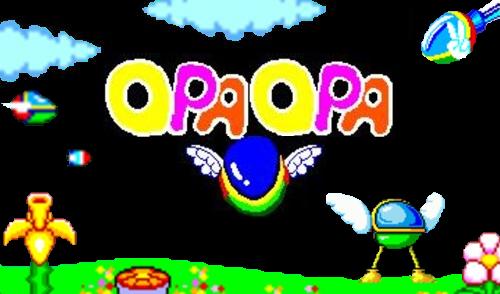 |
|
Character Information :
|
|||||||||||||||||||||
|
Opa-Opa had one of the most unique and recognizable designs of any Sega character ever created. While Master System fans may remember Alex Kidd, it's Opa-Opa who modern gamers recognize more often, even though they may not know his name. So what does he look like? Opa-Opa, since his first game, has always had the same appearance; an egg-like shape, red top, green bottom, glass shield in the front, wings (this can change depending on the power-ups you purchase) and little legs that sprout when he gets close to the ground. Check out this little chap below. Interestingly, this image has held for every appearance he has made, making him perhaps the most timeless character in Sega's history. Even more interesting, however, is the story behind him, or at least what's currently known about it.
Opa-Opa first appeared in the arcade version of Fantasy Zone released in March of 1986, which then debuted on the Mark III in June of the same year. Konami had already released Twinbee, so Sega had to merely mess with the concept somewhat to come up with something more original, since the other series was admittingly nothing more than just another shooter in its basic format. Mu Tsu, after speaking with a programmer from Konami, came up with the idea that would, with the other, come to define a sub-category of shooters known as the 'cute-em' up'. However, the designers of Fantasy Zone decided to do something different. Instead of a vertical scroller, they made the game horizontal, but, taking a clue from games like Defender and Championship Lode Runner, made control of Opa-Opa entirely up to the player, instead of determined by a continuously moving screen. In addition, Opa-Opa doesn't receive power-ups from enemies he eliminates, but collects coins with which he can purchase a variety of items including jet boosters, bigger wings, bombs and extra lives. In addition, the game is unique in that you're required to completely destroy a series of non-moving 'bases' in order to fight a boss and continue on to the next level. Combine this with some crazy character and background designs and Opa-Opa was destined for greatness. In this game we learn, based on the manual, that Opa-Opa seems to be a person or at least an alien, inside an 'expandable spaceship'. So popular was the game that it was ported to a variety of systems including the Famicom, MSX and NES. As we all know, the Master System version was by far the most impressive for its time. However, there were more games to come that further served to obscure his true identity and led to problems mentioned above... In 1987, hardly one year after Fantasy Zone was released, Sega came out with a sequel, Fantasy Zone II in the arcades and on the Mark III/Sega Master System. In Japan, the full title was Fantasy Zone II: The Tears of Opa-Opa, but this title is still retained on the title screen of other versions, though not on the box inserts and manuals. Regardless, the character returned for an even better adventure. The basic format was kept the same but improved on drastically, so much so that I've had friends mistake the game for a 16-Bit title. This time, Opa-Opa takes on the Blackhearts and can essentially purchase the same weapons as before, though there were some additions including a purchasable life bar and invincibility shield. However, the game also introduced a series of warps (more as you progress), requiring the player to find each one hidden behind the bases to move on to other areas in the levels before finally locating the final warp to get to the boss. This made the game even more interesting in that it was essentially non-linear with a bit of an element of strategy. With secret shops and other goodies to find, it was definitely an improvement over the original, though Opa-Opa and the basic gameplay were essentially the same. But the problem becomes further complicated, because shortly after the release of Fantasy Zone II, Opa-Opa appeared again in the third game in the series. Unfortunately for Mark III and Master System fans (released elsewhere a year later), the title left much to be desired. Fantasy Zone: The Maze (Opa-Opa in Japan) was totally different from the previous games and designed by a different team, thus the likelyhood for its striking differences. First, you're no longer playing a shooting title, instead, certain elements were retained from the original two games and fused with a maze-like environment in the vein of Pac-Man. The game takes place a year after the first and this time involves Opa-Opa's younger brother Upa-Upa. Based on the manual and artwork, by this time all possibility of a separate alien or human inside the characters seems gone as they have been given eyes and any mention of a pilot is absent. The graphics were well below what even the first game possessed and most of the backgrounds were simply reused from the first Fantasy Zone, overlayed with fairly bland, black mazes and enemies so small their details were sometimes muddled. It seems that by this point, as we saw with Alex Kidd, the character had become the main selling point, not the idea and Sega fans were treated to a game that received lukewarm reviews at best. This appears to be roughly the point where Opa-Opa's image and popularity began to decline. The most likely reason for this phenomenon is the simple fact that the type of games he was featured in all follow the same format. To use a contrasting character we've already gone over, Sonic the Hedgehog, it seems Opa-Opa simply did not have as much workability due to the fact that he was essentially a spaceship. It would have been completely ridiculous to imagine a platforming game where you play as Opa-Opa or anything of this nature, and thus his image became too static to work with. First, in 1991, he was released on the Game Gear in Fantasy Zone Gear, which is in many ways the same game as Fantasy Zone, though apparently you're now playing as Opa-Opa Jr., Opa-Opa's son, whatever that means. Is he alive or what? Come on. The last boss, in fact, appears to be Opa-Opa, taken over again perhaps by his 'evil side' from the second game. This is never explained in the ending however so it seems programmers may have simply been reusing the idea because it worked well for a shooter. As you can see, his image was already too solidified to do anything new with it and he had become so consistent as a shooter character that he could not be developed any further. This wasn't his end, however, and though only one more game was made, he has still retained his popularity and has some reverberations in our current era. Opa-Opa's last official Fantasy Zone appearance occured in Super Fantasy Zone, released for the Megadrive in Europe and Japan. It was never released in the US, unfortunately, which is one of the likely reasons the character eventually fell out of popularity in the states and this may in fact have added to his overall demise. In this game, Opa-Opa has to avenge the death of his father at the hands of the 'Dark Menons', so there's a least a bit of a tie-in to the other titles. The gameplay, however, was essentially the same as all the others with some different enemies and new weapons, but the same, goofy, cartoon-like atmosphere remained, as did Opa-Opa's basic design. He was more refined, but still the same character in what was generally still the same game. Opa-Opa has still managed to live on and part of this reason may be due to the fact that he was such a static character, but at the same time appeared in a series of games that were consistently good, unlike the unfortunate past of our first character, Alex Kidd. Opa-Opa still appears from time to time up to the present day, but in such a way that he remains memorable. One of the main problems was that his name is subservient to the series itself. But, due to its general simplicity by today's standards and excellent gameplay, Fantasy Zone was ported to modern systems such as the Playstation 2 and even on mobile phones, finally solidifying his reputation as one of Sega's most famous characters. He may have been too static to work with, but at least he worked. He has recently even appeared in arcades as one of those blasted, impossible to win ticket machines where you propel little balls into targets to get points and eventually tickets to purchase prizes well below what you paid to win them (that's the picture above). Though he may not be as popular as Sonic the Hedgehog and has yet to appear in any additional games, he will likely remain as one of the most memorable characters to ever glorify the name of Sega, starting from his first release in the arcades and on the Mark III/Master System. As you can see by the chap in the shirt above, he's even become something of a retro character in the same way old Nintendo Power shirts are still being printed in the US, and these issues alone will be certain to retain his image for a very, very long time.
| |||||||||||||||||||||
|
Character
- Gameography :
|
|
| Master System Titles: Other Systems:
Guest Appearances:
|
|
Images of Opa-Opa :
|
|||||||||
|
|||||||||
|
Related Links :
|
|
| |


